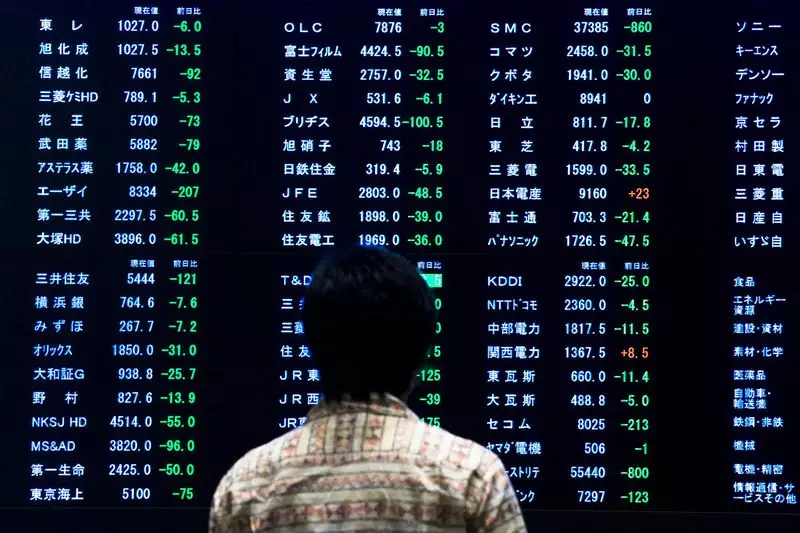In an economic landscape shaped by shifting interest rates and global central bank decisions, Asian stock markets experienced varied reactions on a recent Friday. The overarching theme was influenced by the Federal Reserve’s unexpected interest rate reduction, which cascaded hopes and concerns across the region. While projections of economic growth emanated from previous performances on Wall Street, the Asian markets demonstrated a mix of optimism and caution among investors and analysts alike.
The U.S. Federal Reserve’s decision to reduce interest rates by 50 basis points marked a significant policy shift, igniting a bullish sentiment on Wall Street. This pivotal moment saw the S&P 500 and the Dow Jones Industrial Average reach unprecedented highs, reinforcing the notion that lower borrowing costs could spur economic activity. As a direct consequence, most Asian stocks mirrored the upward trajectory established in the U.S. markets, although with some notable discrepancies. The potential for an extended easing cycle by the Federal Reserve not only created a favorable environment for investors in equities but also intensified discussions on future fiscal stimuli throughout Asia.
Among the Asian counterparts, Japan saw its Nikkei 225 index outperform regional indices with a notable rise of 1.8%. This ascent, however, was somewhat tempered after the Bank of Japan opted to maintain its interest rates, sending mixed signals to the market. While this decision aligned with market forecasts, the BOJ highlighted expectations surrounding increased inflation, which could potentially reshape future monetary policies. The influx of consumer spending, aided by significant wage hikes earlier in the year, suggested a steady economic improvement, yet the central bank’s cautious stance indicated it was treading a fine line between fostering growth and managing inflation.
Interestingly, Japan’s consumer price index (CPI) inflation surged to a 10-month high, marking a pivotal moment that could influence the BOJ’s future policy decisions. While this data signaled growth, it also underscored the mounting pressure on the central bank to adjust its strategies in the face of inflationary trends, particularly as the global economic environment evolves.
Contrasting Japan’s performance, China’s stock markets, including the Shanghai Shenzhen CSI 300 and the Shanghai Composite, demonstrated signs of fatigue, closing slightly lower after attempting to rebound from earlier lows. The main factor dampening sentiment was the People’s Bank of China’s decision to keep its benchmark lending rate unchanged, despite growing calls for initiatives aimed at stimulating the economy.
This situation places China in a complicated position, where sluggish consumer spending and persistent deflation signal underlying economic challenges. Despite an earlier cut to the Loan Prime Rate (LPR), recent economic indicators have painted a stark picture of recovery. The divergence between the need for bolstered economic support and the reality of stagnant growth has created a challenging environment for policymakers in Beijing, as the risk of public dissatisfaction looms larger.
Despite prevalent challenges, there were pockets of strength as technology stocks propelled certain markets upwards. In Hong Kong, the Hang Seng index showed resilience with a 1.3% increase due to gains in technology sectors. Similar positivity resonated in South Korea’s KOSPI, which climbed by 0.8%, driven by investor enthusiasm for tech-oriented investments. This sector’s performance contributed significantly to broader market gains, highlighting the technology industry’s critical role in the current economic fabric.
As regional sentiments shift based on global monetary policy adjustments, the broader Asian markets may continue to reactively oscillate between opportunities and challenges. The Australian ASX 200 recorded an earlier high, reflecting investor confidence in expansive liquidity amid ongoing U.S. interest rate adjustments. However, Indian markets showcased a more tempered response to recent highs, indicating the complex interplay of local and international economic currents.
In essence, while the Asian markets garnered optimism from U.S. performances and Fed’s decisions, underlying economic fundamentals, particularly in Japan and China, hold the key to sustained growth. Investors should remain vigilant as they navigate through this landscape of mixed signals, keeping a close eye on central bank moves and economic indicators.

